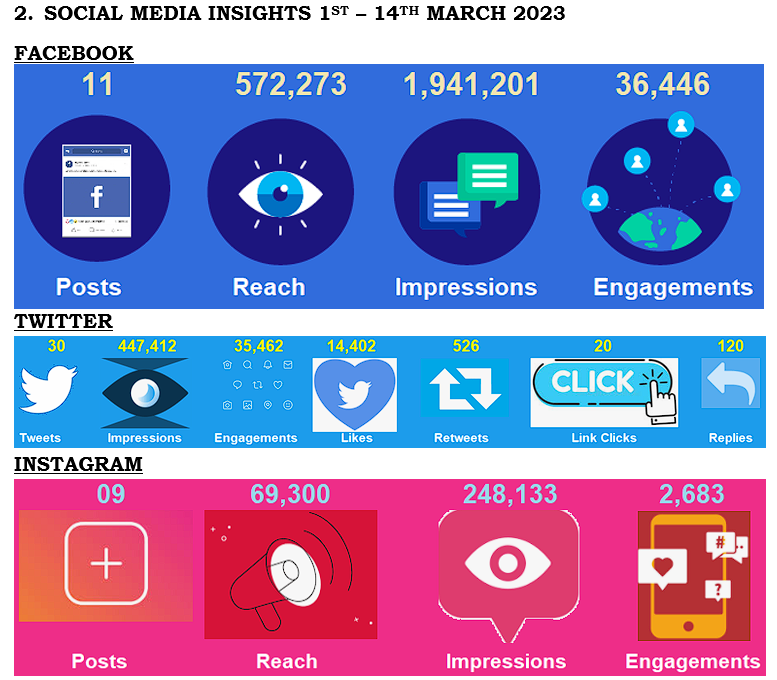


PREPARED BY

OVERVIEW
This report presents findings from the analysis of the coverage of children-related issues in Uganda for the period 15th – 28th December 2023 by various online media platforms. The main method used for analysis was content analysis.
Overall, the analyzed data results show that 347 articles were published online on children and children-related issues in Uganda, indicating a decrease of 95 articles from those published during the first two weeks of December 2023.
One hundred forty (140) articles focused on keeping children safe[1], 135 on keeping children alive[2], and 72 were on keeping children Learning[3].
BI-WEEKLY ANALYSIS OF EDITORIAL AND JOURNALISTIC REPORTING TRENDS BY ONLINE PUBLICATIONS ON CHILDREN IN UGANDA
(DECEMBER 15th – 28th 2023)
- INTRODUCTION
Ultimate Multimedia Consult (UMC) is required to present to UNICEF Uganda every two weeks an analysis of editorial and journalistic reporting trends on children and children-related issues in Uganda as published on online platforms. This report presents findings on how online publications covered children-related issues for the last two weeks of December 2023.
The report also shows how UNICEF Uganda messages, including press releases, reports, and expertise, are reported on by online publications. In addition, the report gives insights into the accuracy and appropriateness of the information provided on children’s issues.
The analysed content was drawn from news websites based in Uganda like: NTV Uganda, Bukedde and Capital FM; other websites like: Daily Monitor, New Vision, Uganda Radio Network, NTV Uganda, Daily Express, Mazima News, PML Daily, Nile Post, The Independent, and Various YouTube Channels like BBS Terefayina, NTV Uganda, UBC TV, Spark TV, Bukedde TV, NBS TV, Urban TV among others, as well as websites based in other countries. The analysed data was accessed from online publications/platforms.
- ONLINE ANALYSIS
We captured 347 articles from online publications reporting children and children-related issues in Uganda during the last weeks of December 2023 (15th – 28th), indicating a decrease of 95 articles from those recorded during the first two weeks of December 2023. Below is a table showing a breakdown by publication and category.
- CATEGORIES
One hundred forty (140) articles were centered on Keeping Children Safe.
Issues related to Keeping Children Safe were reported in 135 articles. Articles on Keeping Children Learning were in 72 articles.

- GENDER OF AUTHORS
During the period under review, male authors reported and/or wrote most articles. While some articles had more than one author, 36 articles had no authors specified.

SENTIMENT
We found that 58% of the articles on children and children related issues published online during the last two weeks of December 2023 had a Positive sentiment[1]. Children-related articles with neutral sentiment were the least in number.

Out of the 94 children-related articles we recorded having a negative sentiment, three (03) articlesmentioned UNICEF. The mentions were in the articles below.
- https://www.medicalnewstoday.com/articles/why-are-cases-of-hiv-infections-on-the-rise-among-girls Why are cases of HIV infections on the rise among girls?
- https://www.middleeastmonitor.com/20231225-2023-to-go-down-as-one-of-the-most-difficult-years-for-children-worldwide-unicef/ 2023 to go down as ‘one of the most difficult’ years for children worldwide: UNICEF
- https://www.dailysabah.com/world/2023-one-of-most-difficult-years-for-children-worldwide-unicef/news 2023 ‘one of most difficult’ years for children worldwide: UNICEF
- SHARE OF VOICE
The majority (85%) of the articles recorded during the last two weeks of December 2023 had a high share of voice[1] on children and children-related issues.

- TYPE OF COVERAGE
The graph below shows the type of coverage of children-related articles online during the period 15th – 28th December 2023

- MESSAGE FIDELITY
The majority (78%) of the children and children-related articles recorded during the last two weeks of December 2023 had high message fidelity. This implies that the messages were laid out clearly through the use of facts, statistics, audio-visuals and sources, making it easy for users to understand them as intended by the authors. Such articles are credible and trusted by content consumers.

- NATURE OF QUOTES
Out of the 347 children-related articles we recorded from online publications, 289 had direct quotes, indicating journalists’ sourcing and clarity in presenting news.

- USE OF VISUALS
In the articles recorded during this period, all 347 articleshadaudio–visuals (photos, videos, audio, and graphics), as shown below.

It should be noted that articles with visuals are understood much better than those without.
- ISSUES COVERED
The graphic below shows the topics covered in children-related articles online. The size of the words in the figure below and the numbers shown in the brackets (after the graphic) reflect the frequency at which the various topics were reported on in online publications.
From the stories captured, we noted that the issue of Child health was the most covered (49 times) during this period. This was followed by:

- Child protection (37)
- Schools (26)
- Child death (25)
- Education (23)
- Parenting (19)
- HIV/AIDS (17)
- Sports and Malaria (16)
- Child Murder (13)
- Food and Nutrition (11)
- WASH (10)
- GBV (10)
Note that some stories covered more than one issue.
- STORY DISTRIBUTION PER REGION

Most (227) of the stories recorded were from the Central region while the Eastern region had the least stories at 62 as represented on the graph above.
While some stories cut across different districts, others were general in nature and therefore were not recorded as coming from any of the four regions of Uganda.

Kampala (167), Kalangala (2), Mukono (3), Wakiso (15), Nakaseke (3), Mubende (11), Mpigi (1), Mityana (2), Masaka (7), Kiboga (1), Kayunga (1), Kassanda (9), Bukomansimbi (2), Buikwe (3), Lwengo (1)

Butaleja (12), Kween (3), Kapchorwa (7), Kumi (3), Kamuli (2), Soroti (2), Sironko (2), Serere (1), Pallisa (1), Mbale (3), Mayuge (1), Luuka (2), Kumi (1), Kibuku (1), Katakwi (1), Buyende (2), Jinja (4), Iganga (7), Busia (2), Bulambuli (2)

Kasese (14), Kazo (5), Rukungiri (5), Ntoroko (5), Kabale (4), Mbarara (3), Kyegegwa (5), Kisoro (4), Kikuube (3), Kamwenge (3), Kagadi (7), Kabarole (2), Hoima (8), Bunyangabu (2), Kyenjojo (1), Kakumiro (1), Ntungamo (1)

Apac (7), Koboko (5), Adjumani (6), Lamwo (5), Nebbi (3), Zombo (2), Yumbe (3), Obongi (2), Oyam (3), Otuke (4), Nwoya (2), Kwania (3), Napak (1), Nebbi (1), Moroto (1), Lira (2), Lamwo (5), Kitgum (4), Gulu (2), Omoro (1), Arua (1), Amuru (2), Otuke (1), Pakwach (3), Madi-Okollo (3), Terego (2)
- UNICEF UGANDA WEBSITE ARTICLES
This part analyzes UNICEF Uganda messages, including press releases, reports and expertise, and how they are reported on by UNICEF Uganda website. No articles were published during the last two weeks of December 2023.
- UNICEF UGANDA MENTIONS
During this period, UNICEF Uganda was mentioned six (06) times in 347 children andchildren-related articles in online publications. Below are links to the articles where UNICEF Uganda was mentioned.
CHILD PROTECTION
- https://www.medicalnewstoday.com/articles/why-are-cases-of-hiv-infections-on-the-rise-among-girls Why are cases of HIV infections on the rise among girls?
- https://www.middleeastmonitor.com/20231225-2023-to-go-down-as-one-of-the-most-difficult-years-for-children-worldwide-unicef/ 2023 to go down as ‘one of the most difficult’ years for children worldwide: UNICEF
- https://www.dailysabah.com/world/2023-one-of-most-difficult-years-for-children-worldwide-unicef/news 2023 ‘one of most difficult’ years for children worldwide: UNICEF
OTHER
- https://www.thenewhumanitarian.org/investigations/2023/12/15/exclusive-investigation-wfp-food-aid-revamp-gone-wrong-refugees-uganda EXCLUSIVE: How a WFP food aid revamp has gone wrong for refugees in Uganda
- https://www.forbes.com/sites/unicefusa/2023/12/18/closing-the-health-inequity-gap-by-investing-in-data-and-technology/?sh=6cefd7bce9f0 Closing The Health Inequity Gap By Investing In Data And Technology
- https://www.newvision.co.ug/category/family/unicef-seeks-14b-to-help-45-million-children-NV_177182 UNICEF seeks $1.4b to help 45 million children at risk of poor health in Africa
- COMPARATOR MENTIONS
The Ministry of Health was the most mentioned comparator in 21 stories, followed by the Ministry of Education & Sports (MoES) with 8, World Food Program with 4 mentions, among other comparators.
Below is a breakdown of all comparator mentions
| COMPARATOR | NUMBER OF MENTIONS |
| MOH | 21 |
| MOES | 8 |
| WFP | 4 |
| Red Cross Society | 3 |
| PEPFAR | 2 |
| TASO | 1 |
| UNAIDS | 1 |
| AU | 1 |
| UNHCR | 1 |
| Uganda AIDS Commission | 1 |
| BRAC | 1 |
| MGLSD | 1 |
| USAID | 1 |
| UNFPA | 1 |
3. SOCIAL MEDIA INSIGHTS 15TH – 28TH DECEMBER 2023

x


YOUTUBE


- SOCIAL MEDIA TRENDS
This part looks at how different media organizations in Uganda posted about children-related issues on social media. During this period, NTV Uganda, The New Vision, Urban TV and Daily Monitor posted the most on children. Posting was mainly on aspects of, FGM, Child-theft, Children born on Christmas day, child-death, WASH, child-torture, immunization, education, girl child, schools, child malnutrition, teaching, child murder, child health, teachers, menstrual hygiene, teenage pregnancy and other sex-related offences against children, reproductive health, maternal and neonatal health, child protection, parenting violence against children, among others. Below are snippets from and links to the posts captured from social media in the last two weeks of December 2023:
https://www.facebook.com/NTVUganda/posts/773107084859878

https://www.facebook.com/NTVUganda/posts/773097628194157

https://www.facebook.com/NTVUganda/posts/772970051540248

https://www.facebook.com/NTVUganda/posts/772949908208929

https://www.facebook.com/NTVUganda/posts/774216494748937

https://www.facebook.com/NTVUganda/posts/775001214670465

https://www.facebook.com/thenewvision/posts/752981270207051

https://www.facebook.com/nbstelevision/posts/783477923817036

https://www.facebook.com/nbstelevision/posts/784313077066854

https://www.facebook.com/nbstelevision/posts/784244823740346

https://www.facebook.com/nbstelevision/posts/784059330425562

https://www.facebook.com/thenewvision/posts/757472666424578

https://www.facebook.com/thenewvision/posts/757421089763069

https://www.facebook.com/thenewvision/posts/757257306446114

https://www.facebook.com/NTVUganda/posts/780902460747007

https://www.facebook.com/NTVUganda/posts/781474057356514

[1] Articles in this category may refer to a journalistic report(s) written and presented in the context of the social safety and welfare including the security of a child. Such articles include any content that addresses issues that threaten the lives of children like physical assault, psychosocial injury and threat.
[2]Reports categorized as such may connote content published in a context of improving and addressing the issues concerning both the informal and formal education of a child, including early and progressive learning.
[3] This is concerned with articles and journalistic content that address the health of children in Uganda. It may also entail articles that look at the welfare of pregnant mothers or maternal health in general.
[4] The measure of the publicity/exposure a brand or issue receives in a story compared to its competitors or other issues.
[5] Sentiment (also known as tonality) is used to measure how messages contained in children related articles are portrayed in the media in relation to UNICEF’s mission to advocate for the protection of children’s rights, help meet their basic needs and expand their opportunities to reach their full potential. Sentiment is normally categorized as positive, neutral or negative.



